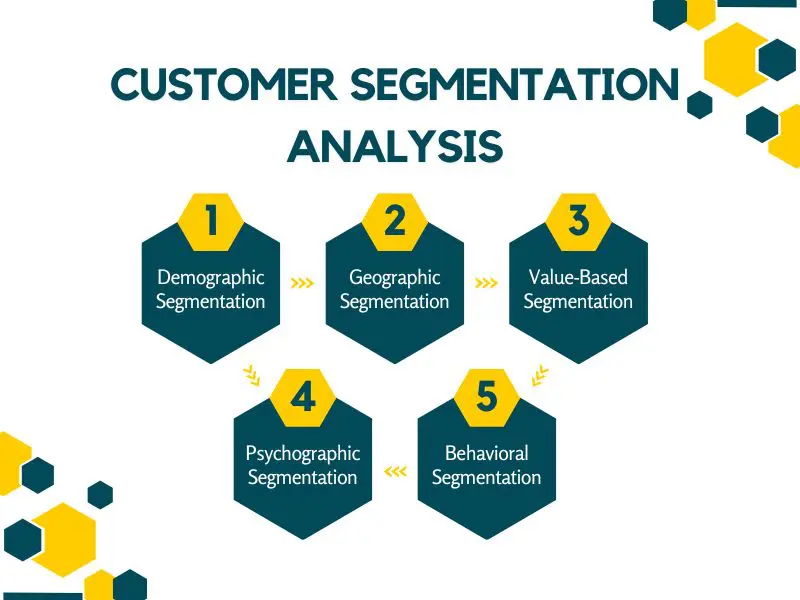What is Customer Segmentation Analysis and Targeting | Types | Examples
The business world is quickly changing. Now, staying ahead of the competition requires a comprehensive understanding of the diverse needs of customers. One strategy that helps you in this situation is – customer segmentation analysis. No longer confined to broad demographic categories, businesses now have the tools to analyze consumer behavior patterns, enabling them to tailor their offerings to specific customer segments.
This shift from mass marketing to personalized interactions has transformed how companies engage with their audiences. Research shows segmentation makes businesses 60% more likely to understand customers’ challenges and concerns. Armed with this information, your sales and marketing teams can reach out to those customers more effectively. This article delves into the details of customer segmentation analysis, its examples, models, and more. Let’s dive in!
What is Customer Segmentation Analysis?
Customer segmentation analysis is a business growth strategy that categorizes a company’s customer base into distinct groups or segments. What sets customer segmentation analysis apart from other techniques is that it’s an analytical approach that goes beyond simple demographic categories. It involves scrutinizing factors such as purchasing behavior, lifestyle choices, geographic location, and even psychographics to create accurate and targeted customer profiles.
This helps you get deeper insights into customer needs and shape your products and solutions to target them more efficiently. As per MailChimp, segmentation led to 14.31% higher email opens and 100.95% more clicks than some non-segmented campaigns. Furthermore, customer segmentation analysis makes it easy to decide what product comes next and how to market and sell it.
Types of Customer Segmentation Analysis
Some of the common types of customer segmentation analysis are:
Demographic Segmentation
Demographic segmentation involves categorizing your customers based on demographic factors such as:
- Age
- Gender
- Income
- Education
- Marital status
This approach provides a foundational understanding of customer groups by identifying common characteristics shared within these categories. For instance, companies like Nike utilize demographic segmentation to tailor their product lines to specific age groups.
Their marketing campaigns might focus on athletic footwear for young adults, showcasing the latest trends and technologies that resonate with this demographic. Simultaneously, they might offer more comfortable and supportive shoes for older adults, recognizing their different preferences and needs.
Geographic Segmentation
Geographic segmentation involves segmenting your customers based on their geographic location. This could range from broad categories like countries or regions to more specific divisions like cities or neighborhoods. You can use geographic segmentation to customize your offerings to suit local preferences and trends.
One of the common customer segmentation examples is McDonald’s, which practices geographic segmentation by adapting its menus to local tastes and cultural preferences. In India, for example, they offer 100% vegetarian options due to dietary restrictions. Whereas in the United States, they go for limited-time products that cater to specific regional flavors, like barbecue burgers, hamburgers, etc.
Value-Based Segmentation
Value-based segmentation categorizes customers based on their economic value to the company. This approach considers metrics such as customer lifetime value, average order value, and frequency of purchases. By identifying your high-value customers, you can allocate resources more effectively to retain and engage these customers.
For instance, airlines like Delta Skyline employ value-based segmentation by offering various tiers of loyalty programs. High-value frequent flyers are granted access to exclusive airport lounges, priority boarding, and enhanced service. This strategy encourages customer retention and brand loyalty among their most valuable clientele while still providing standard service for other segments.
Psychographic Segmentation
Psychographic segmentation involves categorizing customers based on their lifestyle, values, interests, and personality traits. This approach recognizes that customers’ behaviors and purchasing decisions are influenced by more than just demographics. By understanding the psychological aspects that drive customer choices, you can create highly tailored marketing campaigns and experiences.
A common example of a company using psychographic segmentation is Apple. This tech-giant company often targets the “Innovators” and “Tech Enthusiasts” segments. Their branding and messaging highlight cutting-edge technology and sleek design, appealing to customers who value innovation and modernity in their lifestyle.
Behavioral Segmentation
Behavioral segmentation is another customer segmentation analysis type. It involves grouping customers based on their buying behavior, usage patterns, brand loyalty, and responses to marketing efforts. This method considers customer actions and interactions with your business to provide valuable insights into their preferences and motivations. Among many behavioral customer segment examples, Amazon is a popular one.
For instance, if a customer frequently buys cooking and healthy eating books, Amazon’s personalized recommendation system might suggest new cookbook releases, kitchen gadgets, and health-related products. This personalized approach not only enhances the customer’s shopping experience by making it more convenient to discover relevant items but also encourages additional purchases.
Methods of Customer Segmentation Analysis
Some of the popular customer segmentation models are:
Surveys
Surveys involve directly asking customers for their opinions, preferences, and feedback through interviews and questionnaires. This provides valuable insights into demographic, psychographic, and behavioral traits. As a business owner, you can ask customers about their interests, needs, and purchase habits to create targeted segments.
For example, a cosmetics company may survey customers about their preferred makeup styles to create segments like “Natural Look Enthusiasts” and “Bold Makeup Lovers.
Customer Relationship Management (CRM)
CRMs store and manage customer data, facilitating the creation of segments based on factors like purchase history, interaction history, etc. This data-rich approach enables you to develop segments like “Frequent Shoppers” or “Inactive Users” to tailor your marketing strategies.
For instance, a subscription service company can target the “Churn Risk” segment with special offers to prevent customer attrition and improve retention rates.
Analytics Tools
Analytics tools like Google Analytics offer quality data about customer behavior on websites or apps. They track metrics such as most visited pages, average cart value, traffic sources, and goal completion rates. By analyzing this data, you get to identify patterns in user interaction and optimize their online experiences.
For instance, an e-commerce site might notice that users from a certain traffic source have a higher cart value, allowing them to tailor marketing efforts toward that audience.
Benefits of Customer Segmentation Analysis for Your Business
Some of the benefits of customer segmentation analysis for your business are:
Enhanced Customer Experience
By tailoring your offerings to individual segments, you provide a more relevant and enjoyable customer experience. Customers feel understood and valued, which fosters stronger brand loyalty and encourages repeat business.
Efficient Resource Allocation
Customer segmentation analysis helps you allocate your resources more effectively. How? It directs your efforts toward the segments most likely to yield positive results. This optimization prevents wasted time, money, and energy on irrelevant strategies, so your business achieves remarkable success.
Reduced Customer Churn
Utilizing customer segmentation analysis addresses the specific concerns and desires of different segments. This helps you reduce customer churn and offer tailored solutions to prevent customers from seeking alternatives.
Stronger Customer Loyalty
Segmentation also allows you to build deeper connections with customers. When customers feel that your business understands and caters to their preferences, they will likely remain loyal to your brand.
Conclusion
Customer segmentation analysis empowers you to decipher the intricate tapestry of customer behaviors, preferences, and needs. This strategy helps you in personalized marketing, efficient resource allocation, enhanced customer experiences, and more. You can utilize it to go into demographic, psychographic, behavioral, and other customer dimensions. These go beyond generic approaches and create targeted solutions that resonate deeply with your diverse customer base. As a result, you see increased customer loyalty and more significant ROI.






